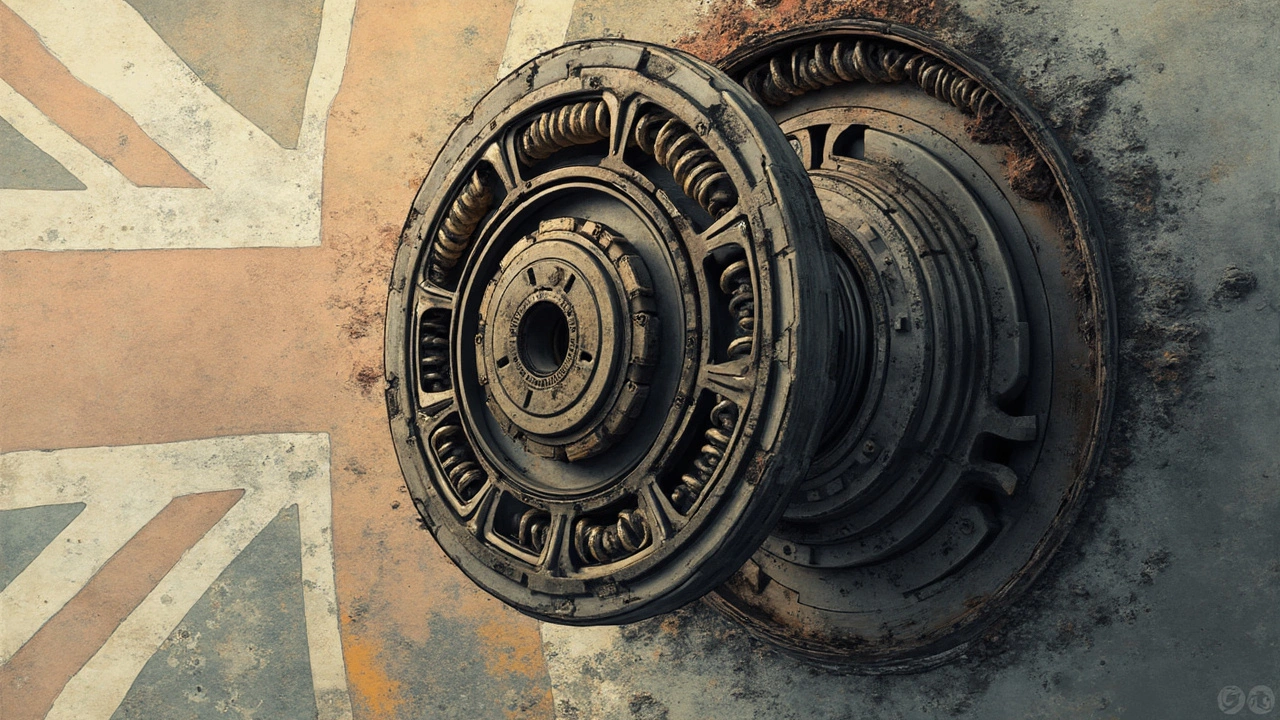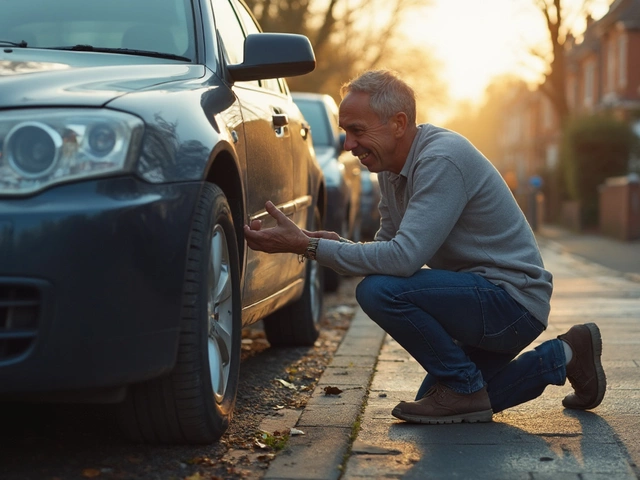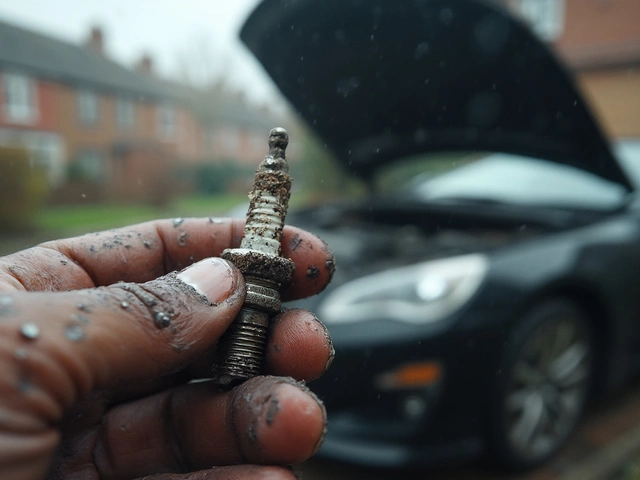If your clutch pedal feels weird, your car is making strange noises, or shifting gears just isn’t smooth anymore, your clutch or flywheel could be the culprit. Too many people shrug off these signs and end up stuck on the side of the road—or with an eye-watering repair bill.
Here’s the reality: catching clutch or flywheel trouble early can save you a lot of time and money. Don’t wait for that burning smell or a total breakdown. It’s all about paying attention to how your car feels and sounds during daily drives.
This isn’t rocket science. You don’t need to be a mechanic to spot most warning signs. By knowing what to watch for, you’ll know when you can keep driving and when it’s time to book it to the shop.
- How the Clutch and Flywheel Work Together
- Warning Signs You Shouldn't Ignore
- Everyday Causes of Clutch and Flywheel Problems
- Simple DIY Checks (No Tools Needed)
- When to Get a Mechanic Involved
- Tips to Make Your Clutch Last Longer
How the Clutch and Flywheel Work Together
Think of the clutch and flywheel like a tag team for your car’s power. The clutch problems most folks run into usually start when these two parts don’t work together like they should. Here’s the gist: the flywheel is a heavy disc that’s bolted to the engine’s crankshaft, and the clutch is what lets you connect or disconnect the engine from the wheels when you use the pedal.
When you press the clutch pedal, you’re temporarily disconnecting the engine (spinning thanks to the flywheel) from the transmission. That’s how you shift gears without grinding noise. Release the pedal, the clutch sticks to the flywheel again, and your car moves forward smoothly. If this teamwork goes bad, you’ll feel it: slipping, shuddering, or jerky starts.
Here’s a simplified breakdown of what happens:
- The engine spins the flywheel at all times
- The clutch disc sits sandwiched between the flywheel and a pressure plate
- Pressing the clutch pedal moves the disc away from the flywheel so you can switch gears
- Letting go of the pedal re-engages the disc, transferring power back to the transmission and wheels
If either part wears out, you’ll notice problems. A worn clutch can slip and fail to grab. A damaged flywheel can cause vibrations or odd noises, especially when you’re starting from a stop.
Most clutches and flywheels last anywhere from 50,000 to 100,000 miles, depending on how you drive and whether you spend lots of time in stop-and-go traffic or tow heavy loads. For a quick look at typical lifespans and repair costs, check this handy table:
| Part | Average Lifespan (Miles) | Replacement Cost (USD) |
|---|---|---|
| Clutch | 50,000 - 100,000 | $700 - $1,200 |
| Flywheel | Same as clutch (replace together) | $400 - $1,000 |
Treating your clutch gently—think smooth gear changes, no riding the pedal—can really stretch out that lifespan and save cash down the line. It’s all about the way these two unsung heroes work as a team to keep your car moving.
Warning Signs You Shouldn't Ignore
Your car usually tells you when the clutch problems or flywheel issues are about to start. Ignoring these early warnings is risky—sometimes, you only get a few days before things get a lot worse and a minor fix turns into a full-on clutch kit replacement.
Most common warning signs you’ll notice include:
- Slipping Gears: If you hit the gas and revs jump up but your car doesn't pull faster, your clutch might be slipping out. This is the classic red flag for clutch trouble.
- Grinding Noise: Hear that scraping or crunching when shifting gears? That’s not normal. It usually means the clutch isn’t fully disengaging, or the flywheel has seen better days.
- Sticky or Spongy Clutch Pedal: When your clutch pedal feels stiff, sticks to the floor, or feels unusually soft, there’s probably a mechanical or hydraulic issue at play.
- Difficulty Shifting: If it takes two hands to shove it into gear, or you hear clunks and feel resistance, your clutch components might not be lining up properly anymore.
- Burning Smell: If you catch a whiff of something burning—especially after a lot of stop-and-go traffic—the clutch could be overheating or slipping.
- Vibrations or Shuddering: The whole car shakes when you let the clutch out, mostly in first gear? The flywheel might be warped or cracked.
Here’s a quick table showing which issues are more likely related to the clutch or the flywheel. This helps you zero in on where the problem could be:
| Symptom | Common Cause | Urgency Level |
|---|---|---|
| Slipping Gears | Clutch Wear | High |
| Vibration/Shudder | Flywheel Issues | Medium-High |
| Burning Smell | Overheated Clutch | High |
| Sticky Pedal | Hydraulic/Mechanical Fault | Medium |
| Difficulty Shifting | Clutch and/or Flywheel | High |
Don’t blow these signs off. If you’re seeing a couple of these symptoms together—especially slipping gears and bad smells—it’s a strong hint your clutch or flywheel needs a closer look. Catching these problems early can keep you on the road and away from big repair bills!
Everyday Causes of Clutch and Flywheel Problems
Most folks don’t realize how easy it is to shorten the life of a clutch or flywheel just by driving the way they always do. The biggest enemy here is bad habits that sneak in during daily commutes, city traffic, or even a fun drive on the weekend.
The most common cause? Riding the clutch. This happens when you keep your foot on the pedal, even a little, when you should let it go completely. That constant pressure wears out the clutch sooner—no surprise, since it's not really getting a break between shifts. A study from AA recently found that drivers who admitted to resting their foot on the clutch needed replacements almost two years earlier than those who didn't.
- Riding or “slipping” the clutch
- Hauling heavy loads or towing
- Constant stop-and-go traffic
- Aggressive shifting and racing launches
- Letting friends drive who don’t really know stick
Heat is the next big culprit. Clutches and flywheels hate high temps—when you slip the clutch too much, it gets hot enough to glaze or warp the flywheel surface. This leads to rough engagement, that burning smell, and sometimes chatter or vibration. If you’ve ever noticed a funky smell after getting stuck in bumper-to-bumper traffic, that’s your warning sign.
| Habit/Cause | Average Impact on Clutch Life |
|---|---|
| Riding clutch pedal | Shortens by up to 20-30% |
| Frequent towing | Shortens by 15-25% |
| Aggressive driving | Shortens by up to 30% |
| City traffic | Shortens by 10-20% |
Here’s what the pros say:
“The number one killer of clutches isn’t age. It’s driver error. The best clutches in the world will fail quickly if they face constant abuse.” — Jeff Masterson, ASE Certified Technician
Keep in mind: the weight of the car matters, too. Bigger vehicles and loaded trunks mean more work for your clutch. Little things pile up quickly and add stress you won’t see until it’s too late—and suddenly, you’re shopping for a whole clutch kit.

Simple DIY Checks (No Tools Needed)
You don’t have to pop the hood or buy fancy gadgets to figure out if something’s off with your clutch or flywheel. You just need your foot, your ear, and a bit of attention while driving. Here’s what you can do:
- Clutch Feel Test: Step on the clutch pedal while your car is off and again while it’s running. It should feel smooth, with a steady resistance. If it’s super easy, sticky, or goes straight to the floor, that could mean the clutch is worn down or the hydraulic system has an issue.
- Listen for Noises: Start your engine, step on the clutch, and listen. If you notice rattling, grinding, or squeaking only when the clutch is pressed, the throwout bearing or flywheel could be in trouble. Noises when shifting gears are a red flag too.
- Engagement Point Check: Find out where the clutch ‘catches’ as you let the pedal up. If the car starts to move when the pedal is barely off the floor or all the way at the top, your clutch might be badly worn.
- Shift Test: While stopped, try shifting into first gear or reverse. Hard shifts or grinding noises mean something isn’t right down below, pointing at possible clutch problems.
- Smell Check: After a drive with lots of stops and starts, sniff for any burnt smell—kind of like burning toast. That’s a giveaway your clutch is slipping and overheating.
If you’re ever unsure about a symptom, here’s a solid bit of advice from Haynes Manuals:
"If the clutch pedal feels abnormal or if shifting is rough, further inspection is needed before more damage occurs."Better safe than sorry. Most of these checks take just minutes but can help catch problems before they turn into nasty surprises.
When to Get a Mechanic Involved
Some clutch and flywheel issues aren’t just inconvenient—they can be flat-out dangerous if you ignore them. If you find yourself forcing the shifter into gear, hear loud grinding noises every time you shift, or if the clutch pedal sinks to the floor and doesn’t come back, it’s time to stop guessing and call in a professional.
Here’s when you really shouldn’t try to tough it out or wait:
- Clutch problems that happen suddenly—like a pedal that sticks or a clutch that won’t engage at all. This points to either a failed clutch cable, master/slave cylinder, or the clutch disc itself.
- Burning smells that don’t go away, especially after normal driving. A fried clutch can damage your flywheel or other pricey transmission parts.
- Strange noises, like metallic screeching or constant grinding—even when the car is sitting still and in neutral. This can mean your release bearing or flywheel is shot.
- Visible leaks near the clutch pedal or around your transmission. Fluid leaks aren’t just messy—they make shifting nearly impossible and lead to bigger repairs.
Replacing a clutch or flywheel isn’t a quick fix you can do in your driveway. Mechanics use lifts and specialty tools to drop the transmission, which is heavy and awkward. The average DIYer can easily get overwhelmed or even hurt trying this at home. Plus, if your car is equipped with a dual-mass flywheel, it needs precise handling and expert installation—otherwise, you just add to your repair costs down the road.
If you have any doubts about what’s going on, or if your car simply won’t move under its own power, don’t risk making things worse. Get it towed or have a trusted mechanic look things over before driving again. The peace of mind is worth it—and you’ll avoid paying twice for a repair gone wrong.
Tips to Make Your Clutch Last Longer
If you want to avoid costly clutch kit repairs and get the most life out of your clutch, a few solid habits can make a huge difference. A typical clutch might last anywhere from 50,000 to 100,000 miles, but rough driving can cut that number in half. So, let’s talk about what actually works to extend your clutch’s life.
- Don’t ride the clutch. Keeping your foot on the clutch pedal while driving puts extra wear on the disc and pressure plate. Only use the clutch when you need to change gears or start from a stop.
- Shift gears smoothly. Quick, jerky shifts make your clutch work harder and build up heat, which can warp the flywheel over time.
- Avoid holding the car on a hill with the clutch. Use your handbrake instead. Holding the clutch halfway while you wait just burns it up for no reason.
- Let the clutch out all the way when possible. Driving with the clutch partially engaged is a fast track to a bad clutch.
- If you’re stuck in traffic, shift into neutral occasionally instead of keeping the clutch down the whole time.
Clutch lifespan isn’t just about driving skill—it’s also about the car and conditions. According to a AAA survey, drivers who used smart clutch habits cut down on clutch problems by up to 30% compared to others in city driving. Here’s a quick comparison:
| Habit | Average Clutch Life (Miles) |
|---|---|
| Rides Clutch Frequently | 45,000 |
| Uses Handbrake on Hills | 80,000 |
| Smooth Shifting/No Riding | 90,000+ |
Modern clutches are pretty tough, but they’re not magic. As Joe Evans, a master mechanic with 30+ years experience, says:
“The easiest way to make your clutch last is to treat it like an on-off switch — clutch in, shift, clutch out. Any time you’re halfway in between, you’re burning money.”
So, take it easy on your clutch and you’ll avoid repairs and keep your wallet a lot happier.




